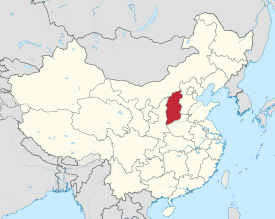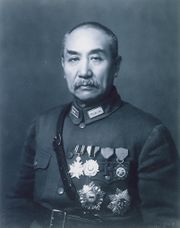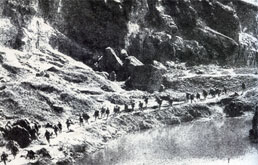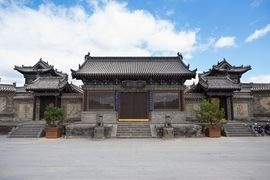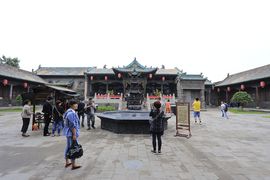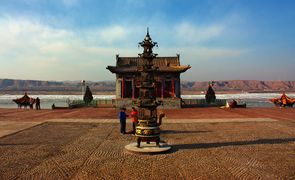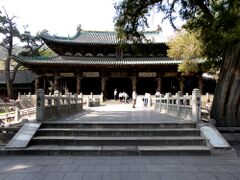شانشي
| ||||||||||||||||||||||||||||||||||||||||||||||||||||||||||||||||
| ||||||||||||||||||||||||||||||||||||||||||||||||||||||||||||||||
شانشي (Chinese: 山西; pinyin: Shānxī; Wade–Giles: Shan-hsi; تهجي الخريطة البريدية: Shansi) هي مقاطعة في الجزء الشمالي من جمهورية الصين الشعبية. اختصارها ذو الحرف الواحد هو جين (晋 پنين jìn)، بعد دولة جين التي تواجدت فيها أثناء فترة الربيع والخريف.
الاسم شانشي يعني حرفياً "غرب الجبل"، الذي يشير إلى موقع المقاطعة غرب جبال تايهانگ.[5] تجاور شانشي خبي إلى الشرق، هـِنان إلى الجنوب، شآنشي إلى الغرب، ومنغوليا الداخلية إلى الشمال. عاصمة المقاطعة هي تاييوان.
شانشي هي المنتج الأول للفحم في الصين، إذ تحوي تقريباً ثلث إجمالي احتياطي الفحم بالصين. إلا أن ن.م.ا. للفرد في شانشي يبقى تحت المتوسط الوطني.
The province is also known for having by far the largest number of historic buildings among all Chinese provinces, by possessing over 70% of China's surviving buildings built during or predating the Song dynasty.[6] Also notable are the Yungang Grottoes in Datong, Shanxi, which date back over 1500 years.
التاريخ
الصين قبل الإمبراطورية
In the Spring and Autumn period (722–403 BC), the state of Jin was located in what is now Shanxi Province. It underwent a three-way split into the states of Han, Zhao and Wei in 403 BC, the traditional date taken as the start of the Warring States period (403–221 BC). By 221 BC, all of these states had fallen to the state of Qin, which established the Qin Dynasty (221–206 BC).
الصين الامبراطورية
Han dynasty (206 BC – AD 220) ruled Shanxi as the province of Bingzhou.
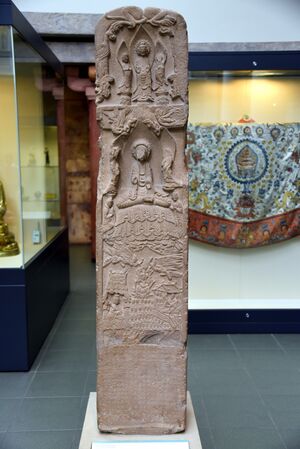 Buddhist votive stele. From China, Shanxi Province. Northern Wei dynasty, ح. 520 CE. Victoria and Albert Museum |
During the invasion of northern nomads in the Sixteen Kingdoms period (304–439), several regimes including the Later Zhao, Former Yan, Former Qin, and Later Yan continuously controlled Shanxi. They were followed by Northern Wei (386–534), a Xianbei kingdom, which had one of its earlier capitals at present-day Datong in northern Shanxi, and which went on to rule nearly all of northern China.
The Tang dynasty (618–907) originated in Taiyuan. During the Tang dynasty and after, present-day Shanxi was called Hédōng (河東), or "east of the (Yellow) river". Empress Wu Zetian, one of China's only female rulers, was born in Shanxi in 624.
During the first part of the Five Dynasties and Ten Kingdoms period (907–960), Shanxi supplied rulers of three of the Five Dynasties. Among the Ten Kingdoms, it was the only one located in northern China. Shanxi was initially home to the jiedushi (commander) of Hedong, Li Cunxu, who overthrew the first of the Five Dynasties, Later Liang (907–923) to establish the second, Later Tang (923–936). Another jiedushi of Hedong, Shi Jingtang, overthrew Later Tang to establish the third of the Five Dynasties, Later Jin, and yet another jiedushi of Hedong, Liu Zhiyuan, established the fourth of the Five Dynasties (Later Han) after the Khitans destroyed Later Jin, the third. Finally, when the fifth of the Five Dynasties (Later Zhou) emerged, the jiedushi of Hedong at the time, Liu Chong, rebelled and established an independent state called Northern Han, one of the Ten Kingdoms, in what is now northern and central Shanxi.
Shi Jingtang, founder of the Later Jin, the third of the Five Dynasties, ceded a piece of northern China to the Khitans in return for military assistance. This territory, called The Sixteen Prefectures of Yanyun, included a part of northern Shanxi. The ceded territory became a major problem for China's defense against the Khitans for the next 100 years, because it lay south of the Great Wall.
The later Zhou, the last dynasty of the Five Dynasties period was founded by Guo Wei, a Han Chinese, who served as the Assistant Military Commissioner at the court of the Later Han which was ruled by Shatuo Turks. He founded his dynasty by launching a military coup against the Turkic Later Han Emperor, however his newly established dynasty was short lived and was conquered by the Song Dynasty in 960.
In the early years of the Northern Song Dynasty (960–1127), the sixteen ceded prefectures continued to be an area of contention between Song China and the Liao Dynasty. Later the Southern Song Dynasty abandoned all of North China, including Shanxi, to the Jurchen Jin dynasty (1115–1234) in 1127 after the Jingkang Incident of the Jin-Song wars.
The Mongol Yuan Dynasty divided China into provinces but did not establish Shanxi as a province. Shanxi only gained its present name and approximate borders during the Ming Dynasty (1368–1644) which were of the same landarea and borders as the previous Hedong Commandery that existed during the Tang Dynasty. During the Qing Dynasty (1644–1911), Shanxi extended north beyond the Great Wall to include parts of Inner Mongolia, including what is now the city of Hohhot, and overlapped with the jurisdiction of the Eight Banners and the Guihua Tümed banner in that area.
For centuries, Shanxi served as a center for trade and banking; the "Shanxi merchants" were once synonymous with wealth. The well-preserved city and UNESCO World Heritage site Pingyao shows many signs of its economic importance during the Qing dynasty.
جمهورية الصين المبكرة (1912–1937)
بانهيار أسرة تشينگ، أصبحت شانشي جزءاً من جمهورية الصين حديثة الإنشاء. From 1911–1949, during the entire period of the Republic of China's period of rule over mainland China, Shanxi was controlled by the warlord Yan Xishan[بحاجة لمصدر]. Early in Yan's rule he decided that, unless he was able to modernize and revive the economy of his small, poor, remote province, he would be unable to protect Shanxi from rival warlords. Yan devoted himself to modernizing Shanxi and developing its resources during his reign over the province. He has been viewed by Western biographers as a transitional figure who advocated using Western technology to protect Chinese traditions, while at the same time reforming older political, social and economic conditions in a way that paved the way for the radical changes that would occur after his rule.[7]
In 1918 there was an outbreak of bubonic plague in northern Shanxi that lasted for two months and killed 2,664 people. Yan's interactions with the Western medical personnel he met with to discuss how to suppress the epidemic inspired him to modernize and improve Shanxi's medical infrastructure which he began by funding the Research Society for the Advancement of Chinese Medicine, based in Taiyuan, in 1921. Highly unusual in China at the time, the school had a four-year curriculum and included courses in both Chinese and Western Medicine. The main skills that Yan hoped physicians trained at the school would learn were: a standardized system of diagnosis; sanitary science, including bacteriology; surgical skills, including obstetrics; and, the use of diagnostic instruments. Yan hoped that his support of the school would eventually lead to increased revenues in the domestic and international trade of Chinese drugs, improved public health, and improved public education. Yan's promotion of a modern curriculum and infrastructure of Chinese medicine achieved limited success, but much of the teaching and publication that this school of medicine produced was limited to the area around Taiyuan: by 1949 three of the seven government-run hospitals were in the city. In 1934 the province produced a ten-year-plan that envisaged employing a hygiene worker in every village, but the Japanese invasion in 1937 and the subsequent civil war made it impossible to carry these plans out. Yan's generous support for the Research Association for the Improvement of Chinese Medicine generated a body of teaching and publication in modern Chinese medicine that became one of the foundations of the national institution of modern traditional Chinese medicine that was adopted in the 1950s.[8]
Yan invested in Shanxi's industrial infrastructure, and by 1949 the area around Taiyuan was a major national producer of coal, iron, chemicals, and munitions.[9] Yan was able to protect the province from his rivals for the period of his rule partially due to his building of an arsenal in Taiyuan that, for the entire period of his administration, remained the only center in China capable of producing field artillery. Yan's army was successful in eradicating banditry in Shanxi, allowing him to maintain a relatively high level of public order and security.[10]
Yan went to great lengths to eradicate social traditions which he considered antiquated. He insisted that all men in Shanxi abandon their Qing-era queues, giving police instructions to clip off the queues of anyone still wearing them. In one instance, Yan lured people into theatres in order to have his police systematically cut the hair of the audience.[10] He attempted to combat widespread female illiteracy by creating in each district at least one vocational school in which peasant girls could be given a primary-school education and taught domestic skills. After Kuomintang military victories in 1925 generated great interest in Shanxi for the Nationalist ideology, including women's rights, Yan allowed girls to enroll in middle school and college, where they promptly formed a women's association.[11]
Yan attempted to eradicate the custom of foot binding, threatening to sentence men who married women with bound feet, and mothers who bound their daughters' feet, to hard labor in state-run factories. He discouraged the use of the traditional lunar calendar and encouraged the development of local boy scout organizations. Like the Communists who later succeeded Yan, he punished habitual lawbreakers to "redemption through labour" in state-run factories.[10]
After the failed attempt by the Chinese Red Army to establish bases in southern Shanxi in early 1936 Yan became convinced that the Communists were lesser threats to his rule than either the Nationalists or the Japanese. He then negotiated a secret anti-Japanese "united front" with the Communists in October 1936 and invited them to establish operations in Shanxi. Yan, under the slogan "resistance against the enemy and defense of the soil", attempted to recruit young, patriotic intellectuals to his government in order to organize a local resistance to the threat of Japanese invasion. By the end of 1936 Taiyuan had become a gathering point for anti-Japanese intellectuals from all over China.[12]
الحرب مع اليابان والحرب الأهلية الصينية (1937–1949)
The Marco Polo Bridge Incident in July 1937 led the Japanese to invade China, and Shanxi was one of the first areas the Japanese attacked. When it became clear to Yan that his forces might not be successful in repelling the Japanese army, he invited Communist military forces to re-enter Shanxi. Zhu De became the commander of the Eighth Route Army active in Shanxi and was named the vice-commander of the Second War Zone, under Yan himself. Yan initially responded warmly to the re-entry of the arrival of Communist forces, and they were greeted with enthusiasm by Yan's officials and officers. Communist forces arrived in Shanxi just in time to help defeat a decisively more powerful Japanese force attempting to move through the strategic mountain pass of Pingxingguan. The Battle of Pingxingguan was the largest battle won by the Communists against the Japanese.[13]
After the Japanese responded to this defeat by outflanking the defenders and moving towards Taiyuan, the Communists avoided decisive battles and mostly attempted to harass Japanese forces and sabotage Japanese lines of supply and communication. The Japanese suffered, but mostly ignored the Eighth Route Army and continued to advance towards Yan's capital. The lack of attention directed at their forces gave the Communists time to recruit and propagandize among the local peasant populations (who generally welcomed Communist forces enthusiastically) and to organize a network of militia units, local guerrilla bands and popular mass organizations.[13]
Genuine Communist efforts to resist the Japanese gave them the authority to carry out sweeping and radical social and economic reforms, mostly related to land and wealth redistribution, which they defended by labeling those who resisted as hanjian. Communist efforts to resist the Japanese also won over Shanxi's small population of patriotic intellectuals, and conservative fears of resisting them effectively gave the Communists unlimited access to the rural population. Subsequent atrocities committed by the Japanese in the effort to rid Shanxi of Communist guerrillas aroused the hatred of millions in the Shanxi countryside, causing the rural population to turn to the Communists for leadership against the Japanese. All of these factors explain how, within a year of re-entering Shanxi, the Communists were able to take control of most of Shanxi not firmly held by the Japanese.[14]
During the Battle of Xinkou, the Chinese defenders resisted the efforts of Japan's elite Itakagi Division for over a month, despite Japanese advantages in artillery and air support. By the end of October 1937, Japan's losses were four times greater than those suffered at Pingxingguan, and the Itakagi Division was close to defeat. Contemporary Communist accounts called the battle "the most fierce in North China", while Japanese accounts called the battle a "stalemate". In an effort to save their forces at Xinkou, Japanese forces began an effort to occupy Shanxi from a second direction, in the east. After a week of fighting, Japanese forces captured the strategic Niangzi Pass, opening the way to capturing Taiyuan. Communist guerrilla tactics were ineffective in slowing down the Japanese advance. The defenders at Xinkou, realizing that they were in danger of being outflanked, withdrew southward, past Taiyuan, leaving a small force of 6,000 men to hold off the entire Japanese army. A representative of the Japanese Army, speaking of the final defense of Taiyuan, said that "nowhere in China have the Chinese fought so obstinately".[15]
The Japanese suffered 30,000 dead and an equal number wounded in their effort to take northern Shanxi. A Japanese study found that the battles of Pingxingguan, Xinkou, and Taiyuan were responsible for over half of all the casualties suffered by the Japanese army in North China. Yan himself was forced to withdraw after having 90% of his army destroyed, including a large force of reinforcements sent into Shanxi by the central government. Throughout 1937, numerous high-ranking Communist leaders, including Mao Zedong, lavished praise on Yan for waging an uncompromising campaign of resistance against the Japanese. Possibly because of the severity of his losses in northern Shanxi, Yan abandoned a plan of defense based on positional warfare, and began to reform his army as a force capable of waging guerrilla warfare. After 1938 most of Yan's followers came to refer to his regime as a "guerrilla administration".[16]
After the surrender of Japan and the end of the Second World War, Yan Xishan was notable for his ability to recruit thousands of Japanese soldiers stationed in northwest Shanxi in 1945, including their commanding officers, into his army. By recruiting the Japanese into his service in the manner that he did, he retained both the extensive industrial complex around Taiyuan and virtually all of the managerial and technical personnel employed by the Japanese to run it. Yan was so successful in convincing surrendered Japanese to work for him that, as word spread to other areas of north China, Japanese soldiers from those areas began to converge on Taiyuan to serve his government and army. At its greatest strength the Japanese "special forces" under Yan totaled 15,000 troops, plus an officer corps that was distributed throughout Yan's army. These numbers were reduced to 10,000 after serious American efforts to repatriate the Japanese were partially successful. Yan's Japanese army was instrumental in helping him to retain control of most of northern Shanxi during much of the subsequent Chinese Civil War, but by 1949 casualties had reduced the number of Japanese soldiers under Yan's command to 3,000. The leader of the Japanese under Yan's command, Hosaku Imamura, committed suicide on the day that Taiyuan fell to Communist forces.[17]
Yan Xishan himself (along with most of the provincial treasury) was airlifted out of Taiyuan in March 1949. Shortly afterwards Nationalist planes stopped dropping food and supplies for the defenders due to fears of being shot down by the advancing Communists.[18] The Communists, depending largely on their reinforcements of artillery, launched a major assault on April 20, 1949, and succeeded in taking all positions surrounding Taiyuan by April 22. A subsequent appeal to the defenders to surrender was refused. On the morning of April 22, 1949, the PLA bombarded Taiyuan with 1,300 pieces of artillery and breached the city's walls, initiating bloody street-to-street fighting for control of the city. At 10:00 am, April 22, the Taiyuan Campaign ended with the Communists in complete control of Shanxi. Total Nationalist casualties amounted to all 145,000 defenders, many of whom were taken as POWs. The Communists lost 45,000 men and an unknown number of civilian laborers they had drafted, all of whom were either killed or injured.[19]
The fall of Taiyuan was one of the few examples in the Chinese Civil War in which Nationalist forces echoed the defeated Ming loyalists who had, in the 17th century, brought entire cities to ruins resisting the invading Manchus. Many Nationalist officers were reported to have committed suicide when the city fell. The dead included Yan's nephew-in-law, who was serving as governor, and his cousin, who ran his household. Liang Huazhi, the head of Yan's "Patriotic Sacrifice League", had fought for years against the Communists in Shanxi until he was finally trapped in the massively fortified city of Taiyuan. For six months Liang put up a fierce resistance, leading both Yan's remaining Chinese forces and his thousands of Japanese mercenaries. When Communist troops finally broke into the city and began to occupy large sections of it, Liang barricaded himself inside a large, fortified prison complex filled with Communist prisoners. In a final act of self-sacrifice, Liang set fire to the prison and committed suicide as the entire compound burned to the ground.[19]
جمهورية الصين الشعبية (1949–الحاضر)
After Yan's time Shanxi became the site of Mao Zedong's "model brigade" of Dazhai: a utopian communist scheme in Xiyang County that was supposed to be the model for all other peasants in China to emulate. If the people of Dazhai were especially suited for such an experiment, it is possible that decades of Yan's socialist indoctrination may have prepared the people of Shanxi for Communist rule. After the death of Mao, the experiment was discontinued, and most peasants reverted to private farming.[20]
الجغرافيا
المدن الرئيسية:
الأقسام الادارية
Shanxi is divided into eleven prefecture-level divisions, all of them prefecture-level cities:
| الخريطة | # | الاسم | هانزي | هانيو پنين | المقر الاداري |
|---|---|---|---|---|---|

| |||||
| 1 | تاييوان | 太原市 | Tàiyuán Shì | Xinghualing District | |
| 2 | Changzhi | 长治市 | Chángzhì Shì | Chengqu District | |
| 3 | Datong | 大同市 | Dàtóng Shì | Chengqu District | |
| 4 | Jincheng | 晋城市 | Jìnchéng Shì | Chengqu District | |
| 5 | Jinzhong | 晋中市 | Jìnzhōng Shì | Yuci District | |
| 6 | Linfen | 临汾市 | Línfén Shì | Yaodu District | |
| 7 | Lüliang | 吕梁市 | Lǚliáng Shì | Lishi District | |
| 8 | Shuozhou | 朔州市 | Shuòzhōu Shì | Shuocheng District | |
| 9 | Xinzhou | 忻州市 | Xīnzhōu Shì | Xinfu District, Xinzhou | |
| 10 | Yangquan | 阳泉市 | Yángquán Shì | Chengqu District | |
| 11 | Yuncheng | 运城市 | Yùnchéng Shì | Yanhu District |
المناطق الحضرية
| أخفالتعداد حسب المساحة الحضرية لمدن المحافظة والناحية | |||||
|---|---|---|---|---|---|
| # | المدينة | المساحة الحضرية[21] | مساحة المديرية[21] | المدينة نفسها[21] | تاريخ التعداد |
| 1 | تاييوان | 3,154,157 | 3,426,519 | 4,201,592 | 2010-11-01 |
| 2 | داتونگ[أ] | 1,362,314 | 1,737,514 | 3,318,054 | 2010-11-01 |
| (2) | Datong (new district)[أ] | 58,153 | 185,777 | انظر داتونگ | 2010-11-01 |
| 3 | Changzhi[ب] | 653,125 | 764,841 | 3,334,565 | 2010-11-01 |
| (3) | Changzhi (new districts)[ب] | 269,637 | 831,681 | see Changzhi | 2010-11-01 |
| 4 | Yangquan | 623,671 | 722,155 | 1,368,502 | 2010-11-01 |
| 5 | Linfen | 571,237 | 944,050 | 4,316,610 | 2010-11-01 |
| 6 | Jincheng | 476,945 | 476,945 | 2,279,146 | 2010-11-01 |
| 7 | Jinzhong | 444,002 | 635,651 | 3,249,425 | 2010-11-01 |
| 8 | Yuncheng | 432,554 | 680,036 | 5,134,779 | 2010-11-01 |
| 9 | شووژو | 381,566 | 709,087 | 1,714,857 | 2010-11-01 |
| 10 | Xinzhou | 279,875 | 544,683 | 3,067,503 | 2010-11-01 |
| 11 | شياويي | 268,253 | 468,770 | see Lüliang | 2010-11-01 |
| 12 | لوليانگ | 250,080 | 320,142 | 3,727,068 | 2010-11-01 |
| 13 | Jiexiu | 232,269 | 406,517 | see Jinzhong | 2010-11-01 |
| 14 | گاوپينگ | 213,460 | 484,862 | see Jincheng | 2010-11-01 |
| 15 | Yuanping | 202,562 | 491,213 | see Xinzhou | 2010-11-01 |
| 16 | Yongji | 179,028 | 444,724 | see Yuncheng | 2010-11-01 |
| 17 | Hejin | 175,824 | 395,527 | see Yuncheng | 2010-11-01 |
| (18) | Huairen[ت] | 166,231 | 326,849 | see Shuozhou | 2010-11-01 |
| 19 | هووژو | 156,853 | 282,905 | see Linfen | 2010-11-01 |
| 20 | Fenyang | 149,222 | 416,212 | see Lüliang | 2010-11-01 |
| 21 | گوجياو | 146,161 | 205,143 | see Taiyuan | 2010-11-01 |
| 22 | هوما | 137,020 | 240,005 | see Linfen | 2010-11-01 |
- ^ أ ب New district established after census: Yunzhou (Datong County). The new district not included in the urban area & district area count of the pre-expanded city.
- ^ أ ب New districts established after census: Lucheng (Lucheng CLC), Shangdang (Changzhi County), Tunliu (Tunliu County). These new districts not included in the urban area & district area count of the pre-expanded city.
- ^ Huairen County is currently known as Huairen CLC after census.
أكبر المدن في شانشي
المصدر: China Urban Construction Statistical Yearbook 2018 Urban Population and Urban Temporary Population[22] | |||||||||
|---|---|---|---|---|---|---|---|---|---|
| الترتيب | التعداد | الترتيب | التعداد | ||||||
 تاييوان  داتونگ |
1 | تاييوان | 3,979,700 | 11 | شياويي | 295,900 |  Changzhi  Yangquan | ||
| 2 | داتونگ | 1,272,800 | 12 | لوليانگ | 279,000 | ||||
| 3 | Changzhi | 754,800 | 13 | Jiexiu | 222,300 | ||||
| 4 | Yangquan | 638,800 | 14 | Hejin | 220,000 | ||||
| 5 | Linfen | 617,000 | 15 | Yuanping | 188,600 | ||||
| 6 | Yuncheng | 570,000 | 16 | Yongji | 171,000 | ||||
| 7 | Jinzhong | 562,800 | 17 | گوجياو | 163,000 | ||||
| 8 | Jincheng | 498,000 | 18 | هوما | 159,800 | ||||
| 9 | شووژو | 434,100 | 19 | هووژو | 150,100 | ||||
| 10 | Xinzhou | 310,000 | 20 | گاوپينگ | 132,000 | ||||
السياسة
The Governor of Shanxi is the highest-ranking official in the People's Government of Shanxi. However, in the province's dual party-government governing system, the Governor is subordinate to the provincial Communist Party Committee Secretary (中共山西省委书记), colloquially termed the "Shanxi Party Committee Secretary". As is the case in almost all Chinese provinces, the provincial party secretary and Governor are not natives of Shanxi; rather, they are outsiders who are, in practice, appointed by the central party and government authorities.
The province went through significant political instability since 2004, due largely to the number of scandals that have hit the province on labour safety, the environment, and the interconnected nature between the provincial political establishment and big coal companies. Yu Youjun was sent by the central government in 2005 to become Governor but resigned in the wake of the Shanxi slave labour scandal in 2007. He was succeeded by Meng Xuenong, who had been previously sacked as Mayor of Beijing in the aftermath of the SARS outbreak. Meng himself was removed from office in 2008 after only a few months on the job due to the political fallout from the 2008 Shanxi mudslide. In 2008, provincial Political Consultative Conference Chair, one of the highest-ranked provincial officials, Jin Yinhuan, died in a car accident.
Since Xi Jinping's ascendancy to General Secretary of the Communist Party of China at the 18th Party Congress, numerous highly ranked officials in Shanxi have been placed under investigation for corruption-related offenses, including four incumbent members of the province's highest ruling council, the provincial Communist Party Standing Committee. These were Chen Chuanping, Nie Chunyu, Du Shanxue, and Bai Yun. They were all removed from office around August 2014. Ling Zhengce, the provincial Political Consultative Conference vice-chair and the older brother of Ling Jihua, the province's Vice Governor Ren Runhou, former Taiyuan party secretary Shen Weichen, Taiyuan police secretary Liu Suiji, vice-chair of the provincial People's Congress Jin Daoming, Yuncheng party secretary Wang Maoshe, and Datong party secretary Feng Lixiang, also fell from grace. Shanxi was therefore the 'hardest hit' province during the anti-corruption campaign under Xi Jinping. Targeted corruption investigations on such a massive scale were unprecedented; it amounted to a wholesale 'cleansing' of Shanxi's political establishment. In the aftermath of the 'political earthquake', party secretary Yuan Chunqing was removed from his post in September 2014, with Wang Rulin 'helicoptered' into the provincial Party Secretary office.
الاقتصاد
The GDP per capita of Shanxi is below the national average. Compared to the provinces in east China, Shanxi is less developed for many reasons. Its geographic location limits its participation in international trade, which involves mostly eastern coastal provinces. Important crops in Shanxi include wheat, maize, millet, legumes, and potatoes. The local climate and dwindling water resources limit agriculture in Shanxi.[23]
Shanxi possesses 260 billion metric tons of known coal deposits, about a third of China's total. As a result, Shanxi is a leading producer of coal in China and has more coal companies than any other province,[24] with an annual production exceeding 300 million metric tonnes. The Datong (大同), Ningwu (宁武), Xishan (西山), Hedong (河东), Qinshui (沁水), and Huoxi (霍西) coalfields are some of the most important in Shanxi. Shanxi also contains about 500 million tonnes of bauxite deposits, about a third of total Chinese bauxite reserves.[25] Industry in Shanxi is centered around heavy industries such as coal and chemical production, power generation, and metal refining.[بحاجة لمصدر] There are countless military-related industries in Shanxi due to its geographic location and history as the former base of the Chinese Communist Party and the People's Liberation Army. Taiyuan Satellite Launch Centre, one of China's three satellite launch centers, is located in the middle of Shanxi with China's largest stockpile of nuclear missiles.
Many private corporations, in joint ventures with the state-owned mining corporations, have invested billions of dollars in the mining industry of Shanxi . Hong Kong billionaire Li Ka-shing made one of his largest investments ever in China in exploiting coal gas in Shanxi. Foreign investors include mining companies from Canada, the United States, Japan, the United Kingdom, Germany and Italy.[بحاجة لمصدر]
The mining-related companies include Daqin Railway Co. Ltd., which runs one of the busiest and most technologically advanced railways in China, connecting Datong and Qinhuangdao exclusively for coal shipping.[بحاجة لمصدر] The revenue of Daqin Railway Co. Ltd. is among the highest among Shanxi companies due to its export of coal to Japan, Korea, and Southeast Asia.
Shanxi's nominal GDP in 2011 was 1110.0 billion yuan (US$176.2 billion), ranked 21st in China. Its per-capita GDP was 21,544 yuan (US$3,154).[26]
Shanxi is affected by cases of bad working conditions in coal mining and other heavy industries. Thousands of workers have died every year in those industries. Cases of child labour abuse were discovered recently.[27][28]
المناطق الصناعية
Taiyuan Economic and Technology Development Zone
Taiyuan Economic and Technology Development Zone is a state-level development zone approved by the State Council in 2001, with a planned area of 9.6 km2 (3.7 sq mi). It is only 2 km (1.2 mi) from Taiyuan Airport and 3 km (1.9 mi) from the railway station. National Highways 208 and 307 pass through the zone. So far, it has formed a "four industrial base, a professional industry park" development pattern.[29]
Taiyuan Hi-Tech Industrial Development Zone
Established in 1991, Taiyuan Hi-Tech Industrial Development Zone is the only state-level high-tech development zone in Shanxi, with total area of 24 km2 (9.3 sq mi). It is close to Taiyuan Wusu Airport and Highway G208. The nearest port is Tianjin.[30]
النقل
The transport infrastructure in Shanxi is highly developed. There are many important national highways and railways that connect the province with neighboring provinces.[31]
الطرق
Shanxi's road hub is in the capital, Taiyuan. The major highways in province form a road network connecting all the counties. Examples of major highways are:
- Datong–Yuncheng Expressway
- Taiyuan-Jiuguan Expressway
- Beijing–Hong Kong–Macau Expressway
- Beijing–Tianjin–Tanggu Expressway
السكك الحديدية
Shanxi has extensive rail infrastructure to neighboring provinces. The rail network connects to major cities Taiyuan, Shijiazhuang, Beijing, Yuanping, Baotou, Datong, Menyuan and Jiaozuo. The province also have extensive rail network to coastal cities such as Qinhuangdao, Qingdao, Yantai and Lianyungang.[31]
The province has a rail network called the Shuozhou-Huanghua Railway. It will service Shenchi county in Shanxi with Huanghua port in Hebei. It will become the second largest railway for coal transport from west to east in China.[32]
الطيران
Shanxi's main aviation transport hub is Taiyuan Wusu Airport (IATA: TYN). The airport has routes connecting Shanxi to 28 domestic cities including Beijing, Xi'an, Chengdu and Chongqing. There are international routes to Hong Kong, Singapore, Japan and Russia. There is also another airport in Datong, which has domestic routes to other mainland cities.[31][33]
الديمغرافيا
السكان في معظمهم صينيو الهان مع أقليات من منغول، مانچو، وهوي.
| Ethnic groups in Shanxi, 2000 census | ||
|---|---|---|
| العرقية | التعداد | النسبة |
| صينيو الهان | 32,368,083 | 99.68% |
| هوي | 61,690 | 0.19% |
| مانچو | 13,665 | 0.042% |
| منغول | 9,446 | 0.029% |
In 2004, the birth rate was 12.36 births/1,000 population, while the death rate was 6.11 deaths/1,000 population. The sex ratio was 105.5 males/100 females.[34]
الأديان
الأديان في شانشي [35][note 1]
The predominant religions in Shanxi are Chinese folk religions, Taoist traditions and Chinese Buddhism. According to surveys conducted in 2007 and 2009, 15.61% of the population believes and is involved in cults of ancestors, while 2.17% of the population identifies as Christian.[35] The reports didn't give figures for other types of religion; 82.22% of the population may be either irreligious or involved in worship of nature deities, Buddhism, Confucianism, Taoism, folk religious sects, and small minorities of Muslims.
Military police demolished a large Christian church known as Jindengtai ("Golden Lampstand") in Linfen, Shanxi, in early January 2018.[36]
وفي 2010، كان يوجد 59,709 مسلم في شانشي.[37]
Chenghuangshen (City God) Temple of Pingyao.
- Cathedral of the Immaculate Conception in Taiyuan 01 2012-09.JPG
الثقافة
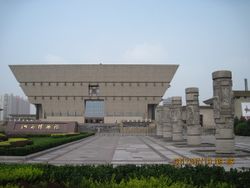
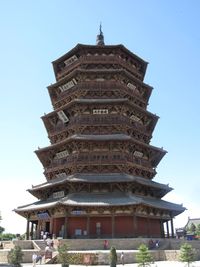
اللغة
The dialects spoken in Shanxi have traditionally been included in the Northern or Mandarin group. Since 1985, some linguists have argued that the dialects spoken in most of the province should be treated as a top-level division called Jin, based on its preservation of the Middle Chinese entering tone (stop-final) category, unlike other dialects in northern China. These dialects are also noted for extremely complex tone sandhi systems. The dialects spoken in some areas in southwestern Shanxi near the borders with Henan and Shaanxi are classified in the Zhongyuan Mandarin subdivision of the Mandarin group.
انظر أيضاً
تذييل
- ^ The data was collected by the Chinese General Social Survey (CGSS) of 2009 and by the Chinese Spiritual Life Survey (CSLS) of 2007, reported and assembled by Xiuhua Wang (2015)[35] in order to confront the proportion of people identifying with two similar social structures: ① Christian churches, and ② the traditional Chinese religion of the lineage (i. e. people believing and worshipping ancestral deities often organised into lineage "churches" and ancestral shrines). Data for other religions with a significant presence in China (deity cults, Buddhism, Taoism, folk religious sects, Islam, et. al.) was not reported by Wang.
- ^ هذا قد يضم:
- بوذيون؛
- كونفوشيون؛
- عبدة الآلهة؛
- طاويون؛
- أعضاء folk religious sects؛
- أقليات ضئيلة من المسلمين؛
- And people not bounded to, nor practicing any, institutional or diffuse religion.
الهامش
- ^ "Geography". Shanxi Tourism Bureau. Retrieved 5 August 2013.
- ^ "Communiqué of the Seventh National Population Census (No. 3)". National Bureau of Statistics of China. 11 May 2021. Retrieved 11 May 2021.
- ^ GDP-2020 is a preliminary data "Home - Regional - Quarterly by Province" (Press release). China NBS. March 1, 2021. Retrieved March 23, 2021.
- ^ "China National Human Development Report 2016" (PDF). United Nations Development Programme. 2016. p. 146. Retrieved 2017-12-05.
- ^ (صينية) Origin of the Names of China's Provinces, People's Daily Online.
- ^ "地上文物看山西,太原纯阳宫"变身"山西古建筑博物馆". 13 April 2020.
- ^ Gillin, Donald G. "Portrait of a Warlord: Yen Hsi-shan in Shansi Province, 1911–1930." The Journal of Asian Studies. Vol. 19, No. 3, May, 1960. Retrieved February 23, 2011. p.289
- ^ Harrison, Henrietta. "The Experience of Illness in Early Twentieth-Century Shanxi.". East Asian Science, Technology, and Medicine. No.42. pp.39–72. 2015. pp.61–63.
- ^ Goodman, David S. G. "Structuring Local Identity: Nation, Province and County in Shanxi During the 1990s". The China Quarterly. Vol.172, December 2002. pp.837–862. Retrieved April 17, 2019. p.840
- ^ أ ب ت Gillin, Donald G. "Portrait of a Warlord: Yen Hsi-shan in Shansi Province, 1911–1930." The Journal of Asian Studies. Vol. 19, No. 3, May, 1960. Retrieved February 23, 2011. p.295
- ^ Gillin, Donald G. Warlord: Yen Hsi-shan in Shansi Province 1911–1949. Princeton, New Jersey: Princeton University Press. 1967. p.24"
- ^ Feng Chongyi and Goodman, David S. G., eds. North China at War: The Social Ecology of Revolution, 1937–1945. Lanham, Maryland: Rowman and Littlefield. 2000. ISBN 0-8476-9938-2. Retrieved June 3, 2012. p.157-158.
- ^ أ ب Gillin, Donald G. Warlord: Yen Hsi-shan in Shansi Province 1911–1949. Princeton, New Jersey: Princeton University Press. 1967. pp. 263–264
- ^ Gillin, Donald G. Warlord: Yen Hsi-shan in Shansi Province 1911–1949. Princeton, New Jersey: Princeton University Press. 1967. p.271
- ^ Gillin, Donald G. Warlord: Yen Hsi-shan in Shansi Province 1911–1949. Princeton, New Jersey: Princeton University Press. 1967. p. 272-273
- ^ Gillin, Donald G. Warlord: Yen Hsi-shan in Shansi Province 1911–1949. Princeton, New Jersey: Princeton University Press. 1967. pp.273–275, 279
- ^ Gillin, Donald G. and Etter, Charles. "Staying On: Japanese Soldiers and Civilians in China, 1945–1949." The Journal of Asian Studies. Vol. 42, No. 3, May, 1983. Retrieved February 23, 2011. pp.506–508
- ^ Gillin, Donald G. Warlord: Yen Hsi-shan in Shansi Province 1911–1949. Princeton, New Jersey: Princeton University Press. 1967. p.288.
- ^ أ ب Spence, Jonathan D. The Search for Modern China, W.W. Norton and Company. 1999. p.488
- ^ Bonavia, David. China's Warlords. New York: Oxford University Press. 1995. p.138.
- ^ أ ب ت 国务院人口普查办公室 [Department of Population Census of the State Council]; 国家统计局人口和社会科技统计司编 [Department of Population and Social Science and Statistics, National Bureau of Statistics] (2012). 中国2010年人口普查分县资料. Beijing: China Statistics Print. ISBN 978-7-5037-6659-6.
- ^ Ministry of Housing and Urban-Rural Development of the People's Republic of China(MOHURD) (2019). 中国城市建设统计年鉴2018 [China Urban Construction Statistical Yearbook 2018] (in الصينية). Beijing: China Statistic Publishing House.
- ^ Infos on Shanxi official website Archived فبراير 20, 2006 at the Wayback Machine
- ^ "Shanxi Province @ The China Perspective". thechinaperspective.com. June 2, 2011. Archived from the original on 2011-06-02.
- ^ 3.9.1 Resources-China Mining Archived 2009-01-08 at the Wayback Machine
- ^ 山西省统计局:山西省人均GDP 已达至3154美元. chinanews.com Shanxi (in الصينية المبسطة). 2010-03-16.
- ^ "Chinese mine blast toll doubles". BBC News. 2009-11-22. Retrieved 2010-05-23.
- ^ "23 miners died and 53 sickened in Shanxi state-owned coal mine | China Labour Bulletin". Archived from the original on July 16, 2011.
- ^ "RightSite.asia | Taiyuan Economic & Technology Development Zone".
- ^ "RightSite.asia | Taiyuan Hi-Tech Industrial Development Zone".
- ^ أ ب ت "Shanxi Province". www.accci.com.au.
- ^ Brief Introduction of Shuozhou Archived 2011-07-07 at the Wayback Machine
- ^ "Datong Transportation: by Air, Train, Bus and Taxi". www.travelchinaguide.com.
- ^ 山西(2004年). Archived from the original on February 21, 2006. Retrieved February 19, 2006.
- ^ أ ب ت China General Social Survey 2009, Chinese Spiritual Life Survey (CSLS) 2007. Report by: Xiuhua Wang (2015, p. 15) Archived 2015-09-25 at the Wayback Machine
- ^ AFP (14 January 2018). "China demolishes Christian megachurch with explosives as religious groups decry 'Taliban-style persecution'". Hong Kong Free Press. Retrieved January 14, 2018.
The huge evangelical Jindengtai ("Golden Lampstand") Church, painted grey and surmounted by turrets and a large red cross, was located in Linfen, Shanxi province. Its demolition began on Tuesday under "a city-wide campaign to remove illegal buildings", the Global Times newspaper reported, quoting a local government official who wished to remain anonymous.
- ^ "Muslim in China, Muslim Population & Distribution & Minority in China". www.topchinatravel.com. Retrieved 2021-07-28.
وصلات خارجية
- Official website (in صينية)
- Economic profile for Shanxi at HKTDC
- Shanxi Community of Canada website (in صينية)
- "Geographic Surveys by Imperial Order", from 1707–1708, is considered one of the first atlases of the Qing dynasty to document the Shanxi area.
- Pages using gadget WikiMiniAtlas
- CS1 uses الصينية-language script (zh)
- CS1 الصينية-language sources (zh)
- CS1 الصينية المبسطة-language sources (zh-hans)
- Short description is different from Wikidata
- Articles containing simplified Chinese-language text
- Articles containing صينية-language text
- Pages using multiple image with auto scaled images
- Coordinates on Wikidata
- Articles with صينية-language sources (zh)
- Pages using infobox settlement with unknown parameters
- Pages using infobox settlement with missing country
- Articles containing Chinese-language text
- Articles containing traditional Chinese-language text
- Articles with unsourced statements from August 2020
- Articles with hatnote templates targeting a nonexistent page
- Articles with unsourced statements from August 2009
- Official website different in Wikidata and Wikipedia
- شانشي
- مقاطعات جمهورية الصين الشعبية





